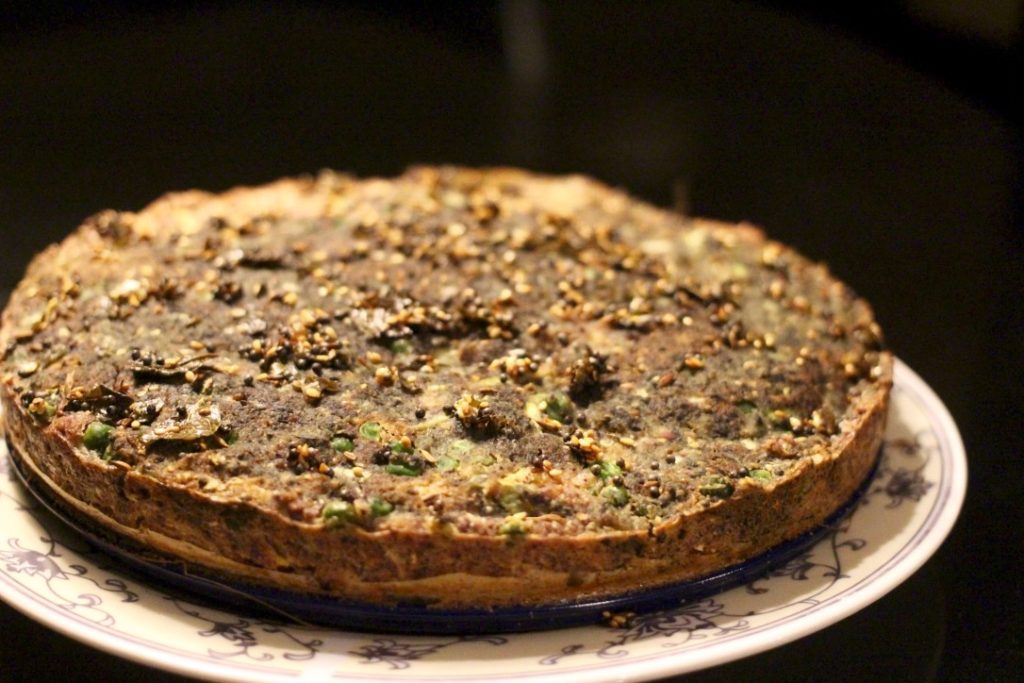
When it comes to Indian cookbooks, I’ve long been a devotee of Madhur Jaffrey. My dal-splattered pages of her original “Indian Cooking” cookbook are accompanied by memories of flavour revelations and culinary triumphs: simmered chicken and lamb curries, my first homemade chicken masala, puffy naan, saag in all its sweet deliciousness and dinner parties that cost $20 total to feed six people. That’s one thing I love Indian cooking; you can go fancy or not and either way there’s going to be a lot of flavour.
But I’m not so stuck in my ways that I wasn’t excited to receive a new cookbook to review, I Love India: Recipes and Stories from city to Coast, Morning to Midnight, and Past to Present from British food writer and television chef Anjum Anand. Indian cuisine varies from region to region, but also from family to family, so I was looking forward to another interpretation of Indian cuisine for Western cooks.
While you might not know the author if you live in Canada, she’s pretty big in the UK. Anand has a lot of recipes already on BBC Food, much like Madhur Jaffrey, so you can check some of them out there, if you like, before buying the new book.
I marked about 20 recipes from the book to test and have now tested about eight. While I always a tarka dal (and there’s a great recipe for that), it was Anand’s less common dishes that jumped out to me: a savoury courgette, seed and curry leaf cake (a Gujarati favourite called handvo, the recipe intro explains); spiced Andhra tomato rice; stir-fried minced lamb with coconut; Bengali sea bream with cauliflower; Bengali fish head rice (fun fact: the local Bengali community is the reason why my local grocery store stocks fish heads on a regular basis, unlike every other store of the chain in downtown Montreal); stir-fried prawns with mustard; Goan mushroom and bean caldine; and Keralan banana leaf-wrapped fish.
I decided to start easy with the handvo (zucchini cake), tandoori seam bream and Bengali stir-fried prawns and mustard, plus some Basmati rice and a quick spinach saag (my recipe, not the book’s: essentially just frozen spinach with a little water, salt and garam masala) to round it out.
I ended up making the courgette cake twice because I messed it up the first time. When recipe testing, the number one rule is never change a recipe, but I’m gluten-free and dairy-free, so I swapped out the yogurt from my homemade soymilk yogurt and the semolina flour for a gluten-free flour. I used a flour blend that had chickpea flour and tapioca starch in it because the recipe already calls for chickpea flour.
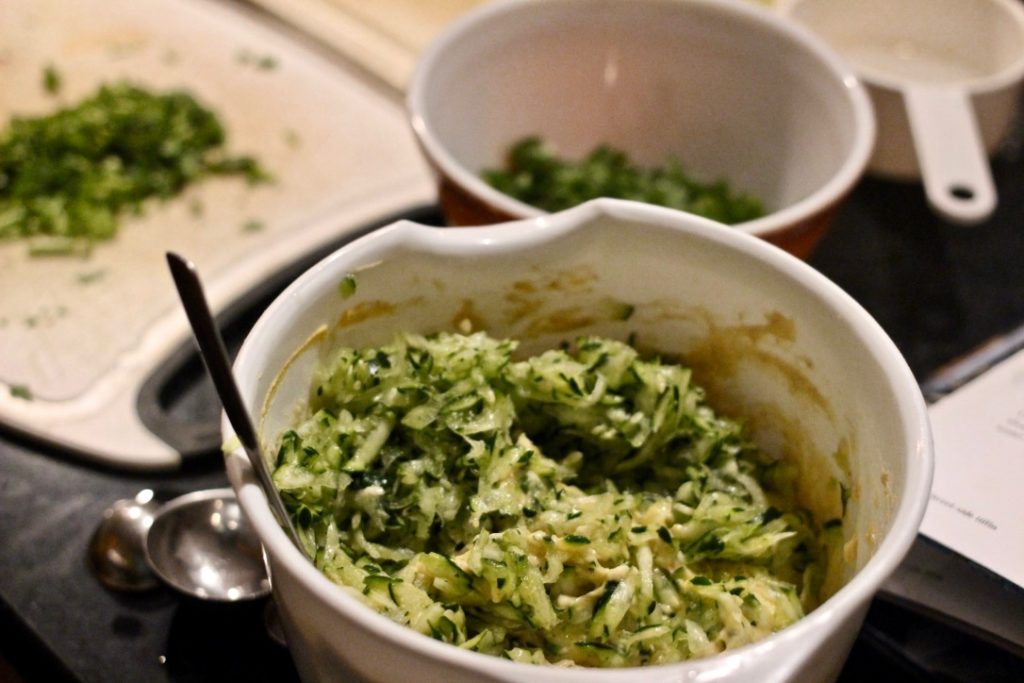
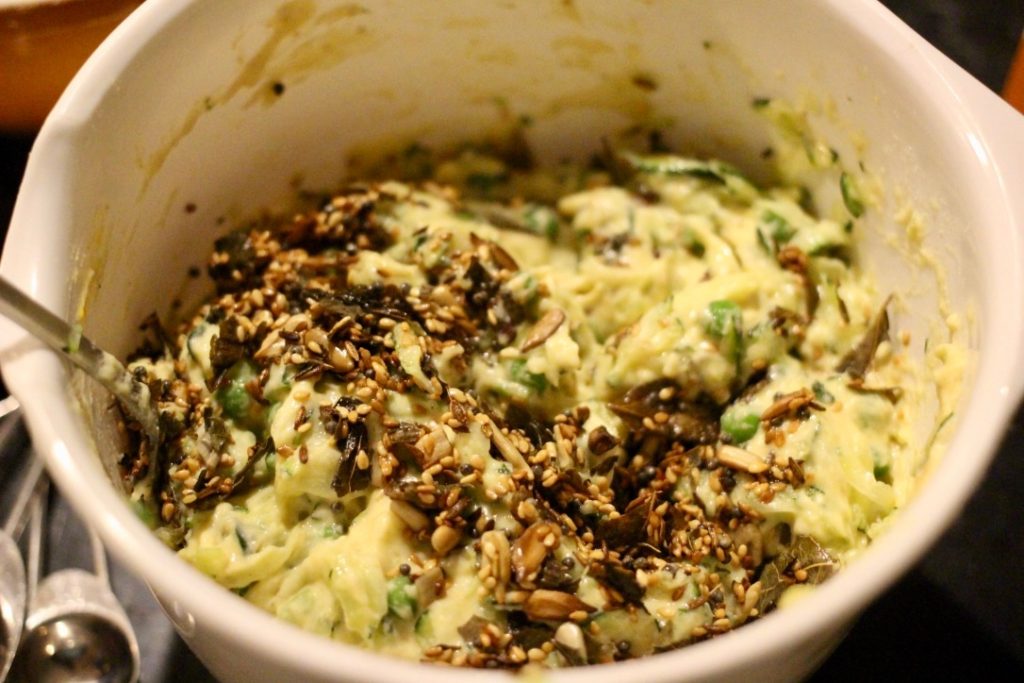
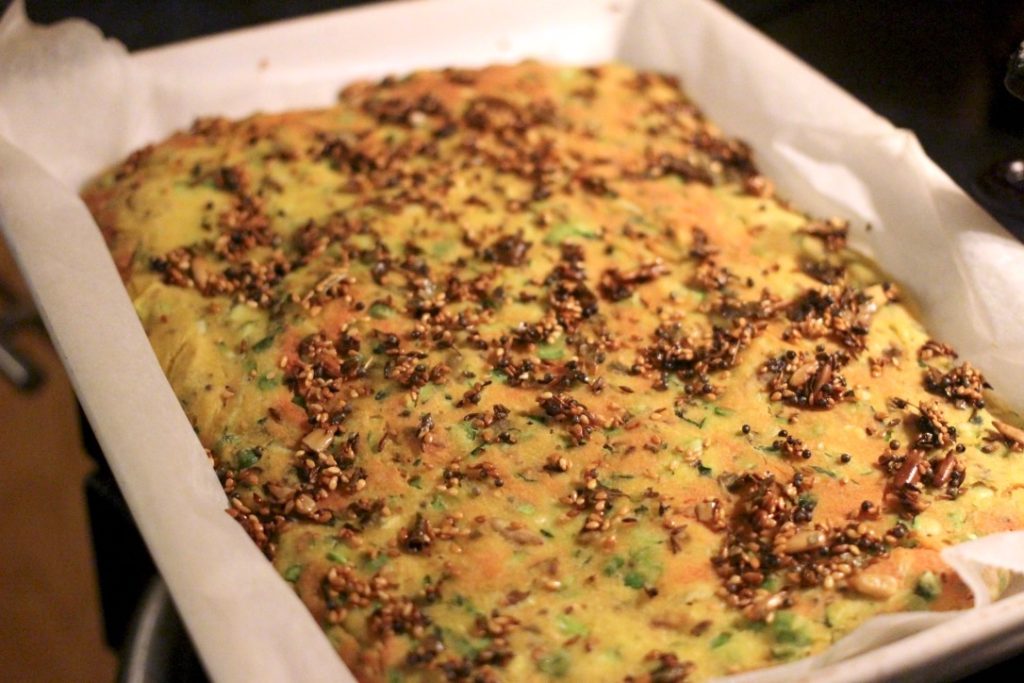
The soymilk yogurt worked fine, but unfortunately the gluten-free flour blend I used has a tendency to stay doughy and undercooked (which I only discovered months later when testing some gluten-free bread recipes), so the cake essentially never cooked through. My friend and I cut pieces from the browned edges as those cooked, but it was very disappointing and gummy, especially since the toasted sesame seeds, pumpkin seeds, cumin and mustard seeds made for a nutty topping to a delicious, savoury cake of grated zucchini and green peas. Even after an hour the cake wasn’t cooked through, and the recipe says it should take 30 minutes.
The second time, though, was a great success. My friend had had the great idea of using cornmeal instead gluten-free flour blend, since semolina has a coarser texture than regular wheat flour anyway. So I was essentially making Indian cornbread with all these delicious nuts, seeds and fried curry leaves on top. I think this book it worth buying just for this recipe. I used an heirloom blue cornmeal from Native Seeds/SEARCH in Tucson, AZ, which gives it a darker colour here, but any cornmeal will work, preferably a coarser one rather than a fine one.

Next, Bengali stir-fried prawns and mustard. This time I changed the recipe for environmental reasons. The only sustainable shrimp I’m confident buying in Montreal are the local Nordic shrimp, which are significantly smaller than the large tiger prawns called for in the recipe.
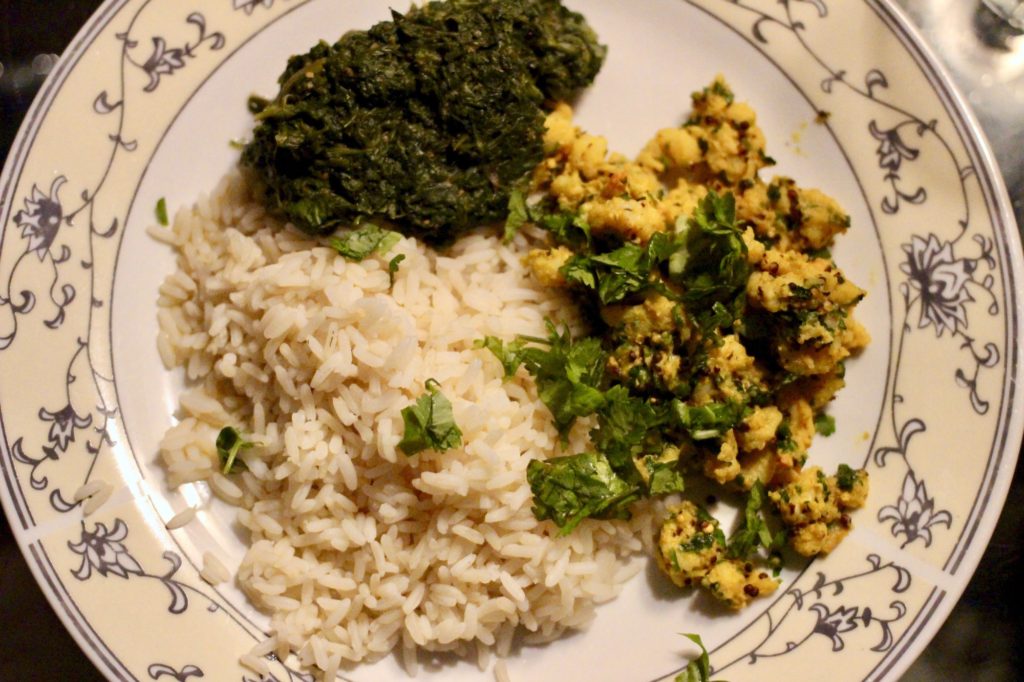
Because of this, the dish ended up being way too salty, as the Nordic shrimp released a lot of salty liquid and we’d already seasoned them with salt. We shouldn’t have added any salt at all. The recipe itself is very simple, with a quick stir-fry of garlic and ginger plus turmeric, mustard seeds and mustard oil (Bengali cooking uses this oil all the time, but there’s controversy over whether or not it should be eaten and whether or not the bottle you purchased is food-grade), plus a little chili powder and coconut cream thrown in at the end. I’d make it again if I had large sustainable shrimp.
And tandoori sea bream. I don’t often have yogurt in my house, so I had to take advantage of my soymilk yogurt while it lasted. That’s why I made tandoori fish. You need a 1/2 cup of yogurt, plus some spices to make the simple marinade. The recipe intro says you can also bake the dish instead of barbecuing it, which worked, but I should have broiled it at the end to make the skin crispy like on a BBQ. Life’s too short for eating flaccid skin.
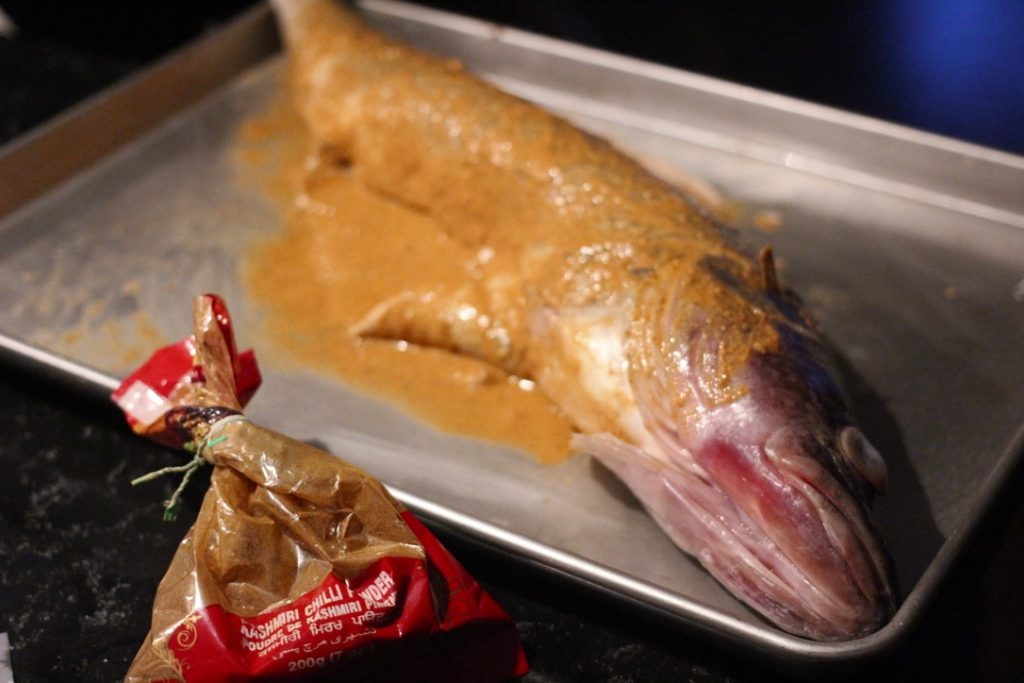
I suspended the fish on a rack rather than skewering it and suspending it as the book suggested. It did the trick of lifting it off the baking sheet, which was the intention, so I’m pretty sure that was fine.
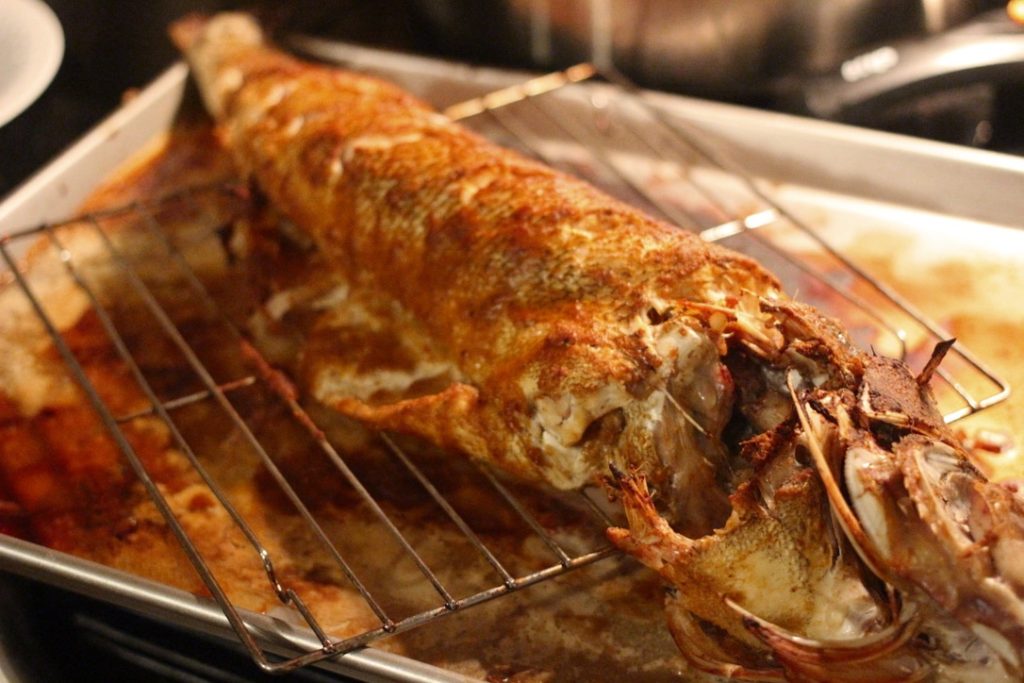
So far, do I love this cookbook? Yes. Any time a recipe hasn’t worked, it’s been my fault. I can picture Anand shaking her head at me, gently. Her recipes work. And while I’ll always revert to Madjur Jaffrey for simple, homestyle Indian dishes, there are plenty of easy recipes, regional specialties, snacks, salads and dinner party wow-ers to get excited about in Anand’s book, too.
I Love India: Recipes and Stories from City to Coast, Morning to Midnight, and Past to Present
Leave a Reply